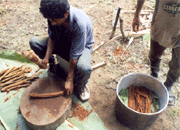| Making
Ayahuasca:
|
What
is Ayahuasca?
The word "Ayahuasca" refers to a medicinal and magical drink incorporating
two or more distinctive plant species capable of producing profound
mental, physical and spiritual effects when brewed together and consumed
in a ceremonial setting. One of these plants is always the giant woody
liana vine called ayahuasca (Banisteriopsis caapi or other species).
The other plant or plants combined with ayahuasca generally contain
tryptamine alkaloids, most often dimethyltryptamine (DMT).
The
plants most often used are the leaves of chacruna (Psychotria viridis
and other species) and oco yagé; also known as chalipanga, chagraponga,
and huambisa (Diplopterys cabrerana). This drink is widely employed
throughout Amazonian Perú, Ecuador, Colombia, Bolivia, western Brazil,
and in portions of the Río Orinoco basin. It has probably been used
in the western Amazon for millennia and is rapidly expanding in South
America and elsewhere through the growth of organized syncretic religious
movements such as Santo Daime, União do Vegetal (UDV), and Barquinia,
among others.
In traditional rainforest practice, other medicinal or visionary plants
are often added to the brew for various purposes, from purely positive
healing (blancura) and divination to malevolent black magic (brujeria,
magia negra or rojo). The oldest known object related to the use of
ayahuasca is a ceremonial cup, hewn out of stone, with engraved ornamentation,
which was found in the Pastaza culture of the Ecuadorean Amazon from
500 B.C. to 50 A.D. It is deposited in the collection of the Ethnological
Museum of the Central University (Quito, Ecuador). This indicates that
ayahuasca potions were known and used at least 2,500 years ago. Its
antiquity in the lower Amazon is likely much greater.
The Ayahuasca medicine usually contains both beta-carboline and tryptamine
alkaloids. However, some indigenous Amazonian cultures, i.e. Yahua and
others, prepare a ceremonial drink from the ayahuasca vine alone. The
effects differ in visionary qualities from the more typical composite
preparation but with the same profound cleansing and spiritual effects.
The beta-carbolines (harmine, harmaline, and tetrahydroharmine) are
obtained from the ayahuasca vine (Banisteriopsis caapi). Harmine and
harmaline are visionary at near toxic levels, but at modest dosage typically
produce mainly tranquility and purgation. Tetrahydroharmine is present
in significant levels in ayahuasca. It may be responsible for some of
its more profound effects compared to analogue plants such as Syrian
rue (Peganum harmala).
The
ratio of these harmala alkaloids in ayahuasca varies greatly from one
geographical area to another in the Amazon basin. The proportions in
which they are present likely accounts for the varied effects reported
by shamans from different 'kinds' of ayahuasca even though all are botanically
classified as Banisteriopsis caapi. |
| Harmala
alkaloids are short term monoamine oxidase inhibitors which render tryptamines
orally active by temporarily reducing levels of monoamine oxidase in
the body which otherwise rapidly destroys them. The combination of specific
serotonin reuptake inhibitors (SSRIs, such as Prozac), and most other
antidepressants, with Ayahuasca or other MAO inhibitors can cause life
support emergencies or death.
The
principal ayahuasca compounds have a common indole structure which,
through several mechanisms, influences certain functions of the central
nervous system (CNS). The relevant factor is the biochemical similarity
of these compounds to the neurotransmitter serotonin (5-HT). The harmala
alkaloids in ayahuasca, primarily harmine and tetrahydroharmine, reversibly
inhibit the neuronal enzyme monoamine oxidase (MAO). This allows DMT
to be active when ingested orally. It also facilitates accumulation
of biogenic amines, such as 5-HT, which are normally metabolized by
monoamine oxidase enzymes.
DMT
is a naturally-occurring biochemical substance secreted by the human
body in the pineal gland. It occurs in hundreds of plant species worldwide.
It can produce very powerful visionary effects when smoked in its pure
form or taken orally in Ayahuasca. |
![]()














